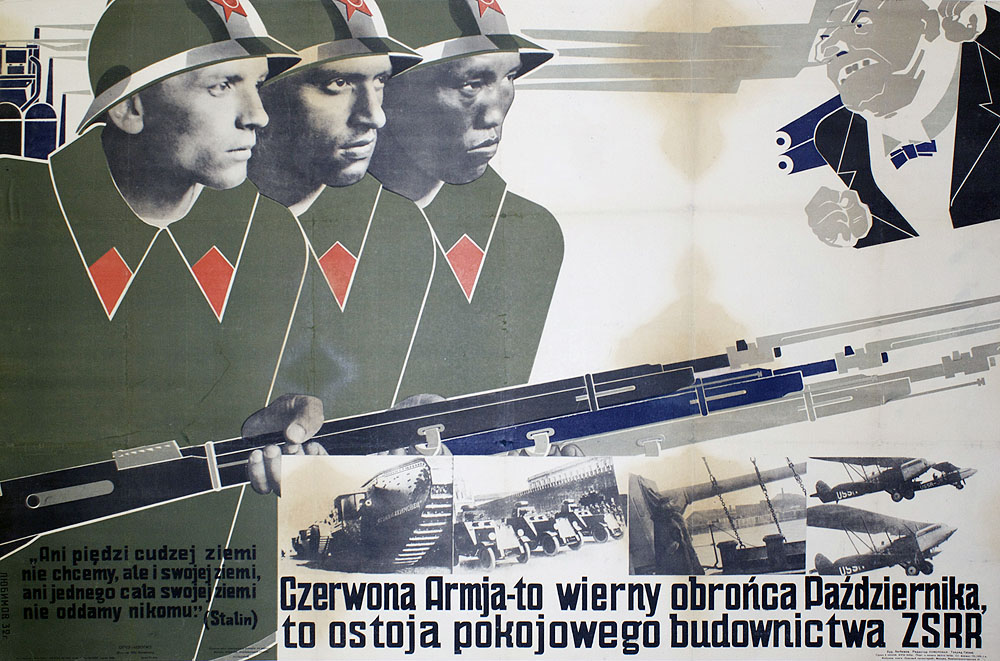
The Red Army is the faithful defender of October, the mainstay of the architecture of peace, the USSR.
Número de Cartel: PP 715
Información sobre el cartel: This poster was printed in various languages and issued during a period of tension along the Russo-Chinese border following the creation of the Japanese State in Manchuria, China. The soldier in the background (of three on the poster) is likely of Evenk (Tungus), or Manchu origin. Evenks are an indigenous people along the Sino-Soviet border. [Text at lower left]: “We do not want an inch of foreign soil, but we will not give up an inch of our territory." -Stalin.
Tamaño: 44x32
Tipo de cartel: Litografía y Offset
Fecha de publicación: 1932
Editores: Editor E. Povolotskaia; Technical Editor Gusev
Información técnica: Izogiz No. 4982; I. 35; Submitted for production August 9, 1932; Approved for printing August 26, 1932; Order No. 5796; Standard format 73 x 104; Volume 1 sheet of paper; Price 60 kopeks
Ediciones: 1,550
Número de Glavlit: B-252..[illegible]
Fuentes: Mercer and Middlesex Auction catalog: September 2011
En el catologo: PP 715 Military; Sister Poster PP 089
Idioma: Polaco
Artista: Liubimov, Alexander Mikhailovich — Любимов, Александр Михайлович
Alexander Mikhailovich Liubimov was Russian and Soviet-era painter, graphic artist, caricaturist, and art teacher. From 1895 to 1901, Liubimov studied at the School of Technical Drawing of Baron Alexander von Stieglitz in St. Petersburg. Thereafter, he continued at the Higher Art School of Painting, Sculpture and Architecture in the St. Petersburg Imperial Academy of Arts. After graduating in 1909, Liubimov managed the Kharkov Art School from 1912 to 1919. He reportedly was recommended for the job by the noted Russian ...
Leer más...
Imprenta: Krasnii Proletarii (Red Proletarian), Moscow — Красный Пролетарий, Москва
The Krasnii Proletarii Workshop originated under the ownership of Ivan Kushnerev, a Russian entrepreneur who founded the Kushnerev & Company Printing Shop in 1869 in Moscow. When Kushnerev died in 1896, his printing operation was one of the largest in Imperial Russia. In 1919, the printer was nationalized by the Soviets and consigned to the Printing Section of the Moscow Economic Council (MSNKh). Around 1920, it was placed under the Poligrafkiniga (Book and Magazine Printing) Trust and was given ...
Leer más...
Editorial: Ogiz-IzoGiz, Moscow-Leningrad — Огиз-Изогиз, Москва-Ленинград
Ogiz was the Association of the State Book and Magazine Publishers. Its main offices were located in Moscow and in Leningrad. The Sovnarkom of the Russian Socialist Federative Soviet Republic established Ogiz in 1930 to centralize publishing activities under a state monopoly in order to eliminate duplication of printed material, streamline and control publishing production and output, and to create a base for marketing books, training and technical manuals. In 1931, the Central Committee of the USSR ...
Leer más...